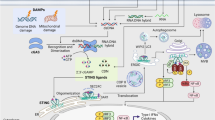Abstract
Surfactin is primarily produced by Bacillus natto TK-1 and is one of the most powerful biosurfactants. It consists of a heptapeptide interlinked with a β-hydroxy fatty acid. Because of its special structure, surfactin shows broad biological effects, including anti-tumour, anti-microbial and anti-mycoplasma activities. It also has potential anti-inflammatory activity; however, the anti-inflammatory mechanism of surfactin has not been explored. In this study, we investigated the anti-inflammatory mechanism of surfactin in lipopolysaccharide (LPS)-stimulated macrophages. Surfactin exhibited an anti-inflammatory effect without cytotoxicity at certain concentrations, and the lipopolysaccharide (LPS)-stimulated cells appeared normal after surfactin treatment. Surfactin significantly inhibited the increased expression of IFN-γ, IL-6, iNOS and nitric oxide (NO). TLR4 is the critical receptor for LPS; therefore, the TLR4 signal transduction pathway is the primary pathway that mediates LPS-induced inflammation. The results show that surfactin downregulated the LPS-induced TLR4 protein expression of macrophages and indicated that the surfactin-mediated signal pathway was involved in with TLR4. The subsequent studies demonstrated that surfactin exhibited anti-inflammatory effects by attenuating the activation of nuclear factor-κB (NF-κB), which is involved in the nuclear factor-κB (NF-κB) cell signalling pathways. These results suggest that surfactin may be a new therapeutic agent for inflammation.







Similar content being viewed by others
References
Lynnette R. Ferguson, William A. Laing 2010. Chronic inflammation, mutation and human disease. Mutation Research 690: 3–11.
Weon-Jong Yoon, Young Min Ham, Sang-Suk Kim, et al. 2009. Suppression of pro-inflammatory cytokines, iNOS, and COX-2 expression by brown algae Sargassum micracanthum in RAW 264.7 macrophages. EurAsian Journal of BioSciences EurAsia J BioSci. 3: 130–143.
Andreasen, A.S., K.S. Krabbe, R. Krogh-madsen, et al. 2008. Human endotoxemia as a model of systemic inflammation. Current Medicinal Chemistry 15: 1697–1705.
Zhu, X., Y. Liu, S. Liu, et al. 2007. Lipopolysaccharide primes macrophages to increase nitric oxide production in response to Staphylococcus aureus. Immunology Letters 112: 75–81.
Pastor, C.M., J. Pugin, B. Kwak, et al. 2004. Role of Toll-like receptor 4 on pancreatic and pulmonary injury in a mice model of acute pancreatitis associated with endotoxemia. Critical Care Medicine 32: 1759–1763.
Cao, X., A.H. Wang, R.Z. Jiao, C.L. Wang, D.Z. Mao, L. Yan, et al. 2009. Surfactin induces apoptosis and G2/M arrest in human breast cancer MCF-7 cells through cell cycle factor regulation. Cell Biochemistry and Biophysics 55: 163–171.
Kim, S.Y., J.Y. Kim, S.H. Kim, H.J. Bae, H.S. Yi, S.H. Yoon, et al. 2007. Surfactin from Bacillus subtilis displays anti-proliferative effect via apoptosis induction, cell cycle arrest and survival signaling suppression. FEBS Letters 581: 865–871.
Qi, G., F. Zhu, P. Du, X. Yang, D. Qiu, Z. Yu, et al. 2010. Lipopeptide induces apoptosis in fungal cells by a mitochondria-dependent pathway. Peptides 31: 1978–1986.
Son, G.H., J. Kim, M.J. Muthaiya, S. Lee, H.Y. Kim, and C.H. Lee. 2011. Antimicrobial compounds profile during Cheonggukjang fermentation against Xanthomonas oryzae pv. oryzae (Xoo). Journal of Microbiology and Biotechnology 21: 1147–1150.
Sun Young Park, Ji-Hee Kim, Sang Joon Lee, et al. 2013. Involvement of PKA and HO-1 signaling in anti-inflammatory effects of surfactin in BV-2 microglial cells. Toxicology and Applied Pharmacology 1: 68–78.
Xiao-hong Cao, Si-si Zhao, Dong-yue Liu, et al. 2011. ROS-Ca2+ is associated with mitochondria permeability transition pore involved in surfactin-induced MCF-7 cells apoptosis. Chemico-Biological Interactions 190: 16–27.
Moretão, M.P., D.F. Buchi, P.A. Gorin, M. Iacomini, and M.B. Oliveira. 2003. Effect of an acidic heteropolysaccharide (ARAGAL) from the gum of Anadenanthera colubrine (Angico branco) on peritoneal macrophage functions. Immunology Letters 89: 175–185.
Yoon, W.J., Y.M. Ham, B.S. Yoo, J.Y. Moon, J. Koh, and C.G. Hyun. 2009. Oenothera laciniata inhibits lipopolysaccharide induced production of nitric oxide, prostaglandin E2, and proinflammatory cytokines in RAW264.7 macrophages. Journal of Bioscience and Bioengineering 107: 429–438.
Bian, K., and F. Murad. 2003. Nitric oxide (NO) biogeneration, regulation, and relevance to human diseases. Frontiers in Bioscience 8: 264–278.
West, N.E.J., H.S. Qian, T.J. Guzik, et al. 2001. Nitric oxide synthase (nNOS) gene transfer modifies venous bypass graft remodeling: effects on vascular smooth muscle cell differentiation and superoxide production. Circulation 104: 1526–1532.
Brynskov, J., P. Foegh, G. Pedersen, et al. 2002. Tumour necrosis factor alpha converting enzyme (TACE) activity in the colonic mucosa of patients with inflammatory bowel disease. Gut 51: 37–43.
Locksley, R.M., N. Killeen, and M.J. Lenardo. 2001. The TNF and TNF receptor superfamilies: integrating mammalian biology. Cell 104: 487–501.
Swardfager, W., K. Lanctôt, L. Rothenburg, et al. 2010. A meta-analysis of cytokines in Alzheimer's disease. Biological Psychiatry 68: 930–941.
Poltorak, A., X. He, I. Smirnova, et al. 1998. Defective LPS signaling in C3H/HeJ and C57BL/10ScCr mice:mutations in Tlr4 gene. Science 282: 2085–2088.
Acknowledgments
This work was supported by these projects in China (2012BAD33B04, 13JCZDJC29800, 31000768, 2012AA022108, 2012GB2A100016, 2013AA102106, 10ZCZDSY07000, 31171731 and IRT1166).
Conflict of Interest
The authors declare no conflicts of interest.
Author information
Authors and Affiliations
Corresponding authors
Rights and permissions
About this article
Cite this article
Zhang, Y., Liu, C., Dong, B. et al. Anti-inflammatory Activity and Mechanism of Surfactin in Lipopolysaccharide-Activated Macrophages. Inflammation 38, 756–764 (2015). https://doi.org/10.1007/s10753-014-9986-y
Published:
Issue Date:
DOI: https://doi.org/10.1007/s10753-014-9986-y




